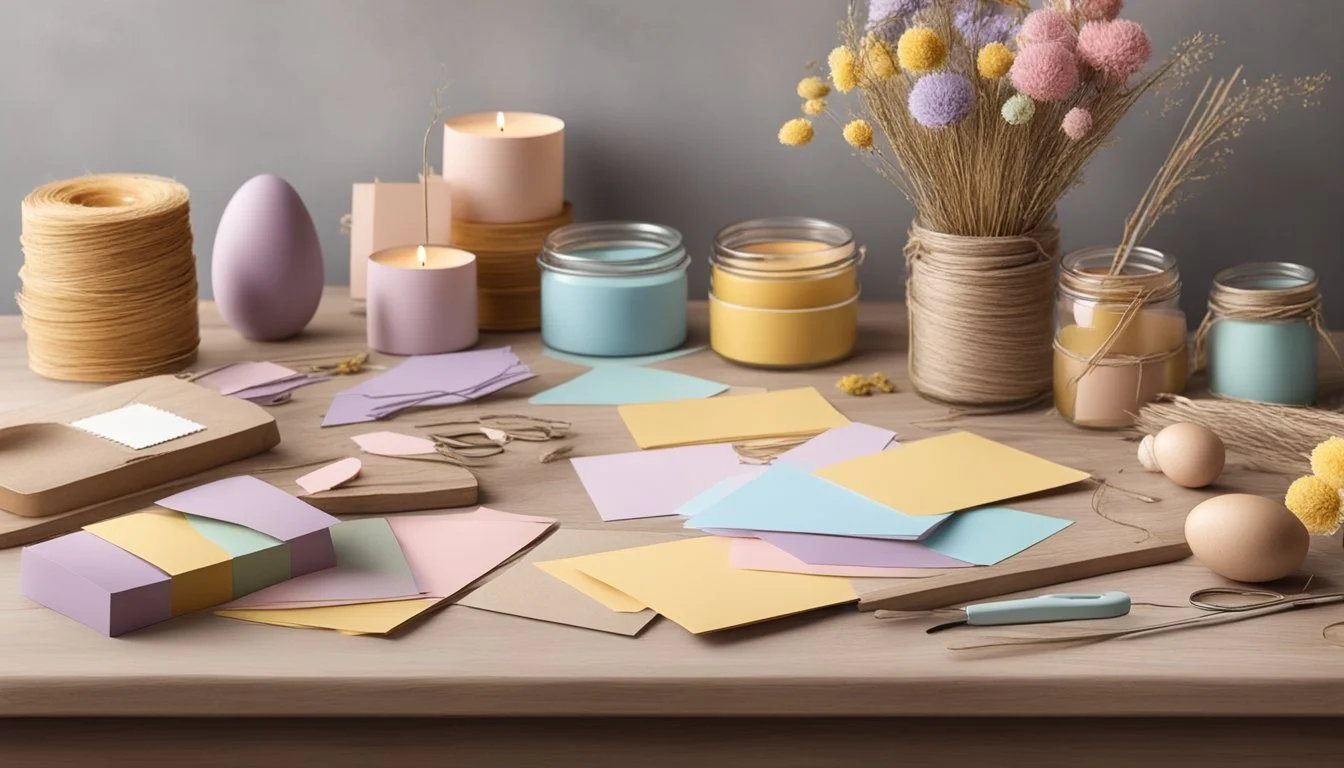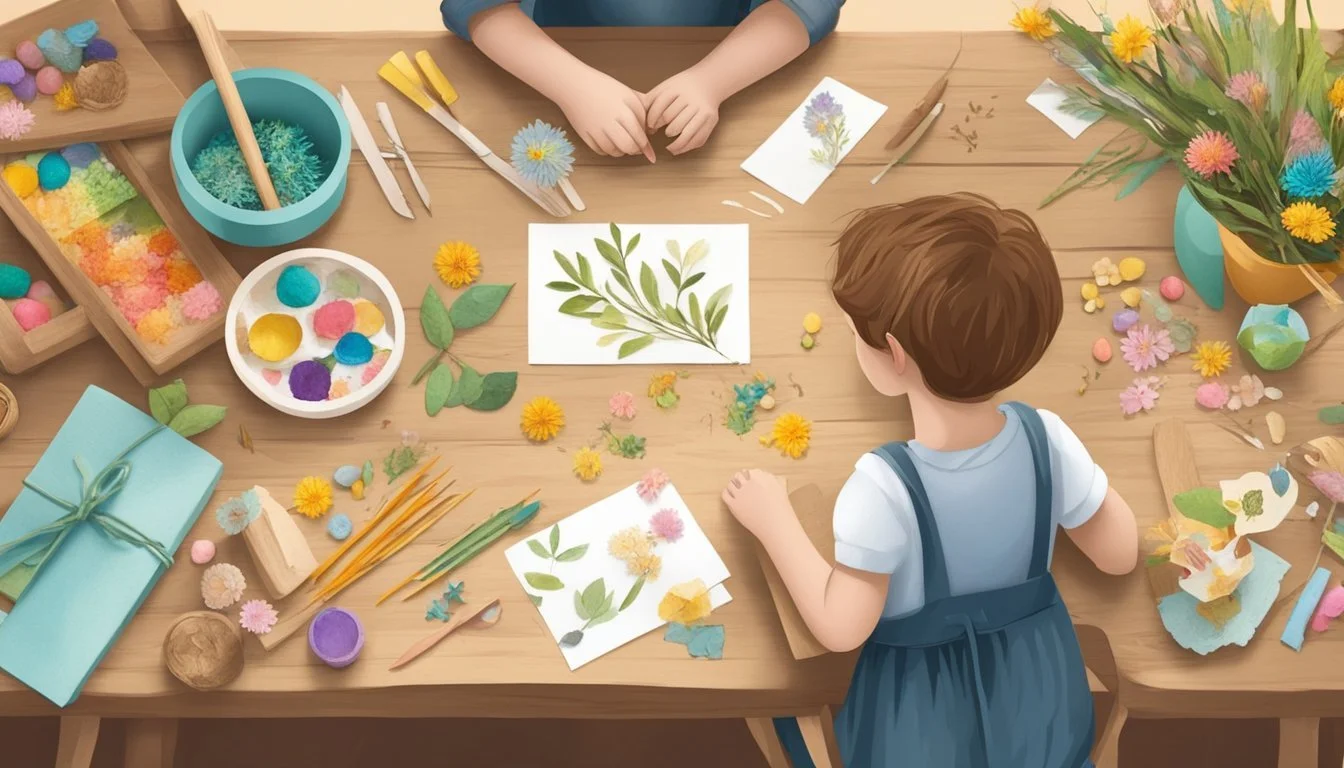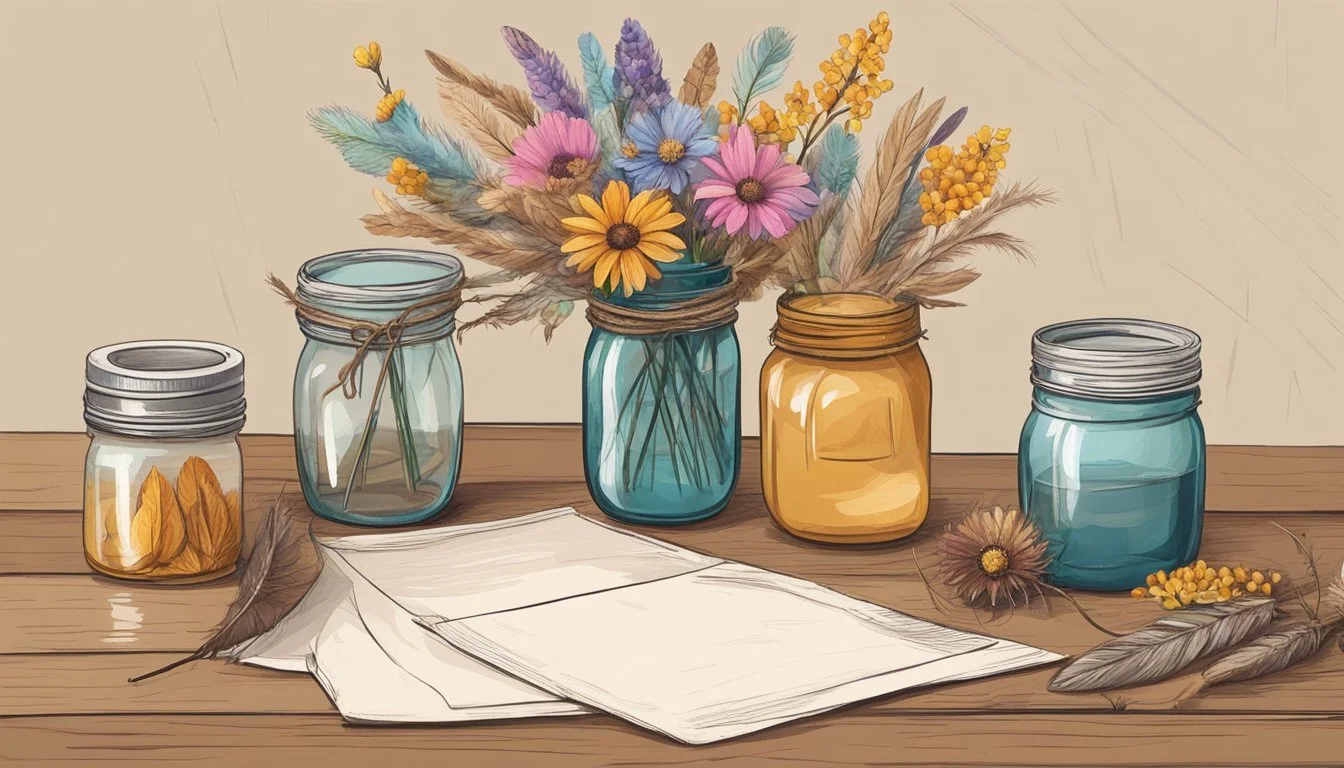Homemade Easter Cards
Crafting with a Rustic Touch for Personalized Celebrations
Easter cards add a personal touch to the festive celebrations, and creating them at home can be a delightful activity that blends creativity with tradition. The trend of making homemade Easter cards is more than just a fun craft; it is a thoughtful way to convey warm wishes to loved ones. These cards often feature elements like Easter eggs, bunnies, and spring flowers, but there is a growing interest in incorporating a rustic farmhouse aesthetic into these designs.
The rustic touch in card-making brings forth a charming, earthy feel that resonates well with the essence of the season. This style is characterized by natural textures, muted colors, and simple, unrefined elements that evoke a sense of coziness and nostalgia. Embracing a DIY approach not only allows for personalization but also gives crafters the freedom to experiment with materials such as twine, burlap, and recycled paper, resulting in unique and eco-friendly Easter greetings.
Crafting Easter cards with a rustic flair can involve techniques such as using paint chip samples to create colorful egg designs, or employing patterned paper to fashion delightful chick or bunny motifs. Whether the goal is to make something whimsical for kids or more sophisticated for adults, the process of making these cards can be a fun and rewarding experience that enhances the festive spirit.
The Appeal of Homemade Easter Cards
Homemade Easter cards offer a creative outlet that merges holiday celebrations with the charm of personal craftsmanship. They allow one to express imagination through a variety of designs and materials.
Celebrating Traditions with a Personal Touch
Handmade cards bring an individual's personal flair to Easter traditions, allowing each card to tell a unique story. This personal touch often becomes a cherished keepsake, capturing memories and conveying emotions in a way that store-bought cards can't match. For instance, incorporating a family photo or a child's drawing into a card creates a one-of-a-kind memento that speaks directly to the recipient's heart.
Benefits of Crafting Your Own Easter Cards
The process of making your own Easter cards isn't just about the end product; it involves several benefits:
Fostering Creativity: Crafting requires one to tap into their imagination, deciding on color schemes, layouts, and themes that best express the joy of Easter.
Cost-Effective: Making cards at home can be more economical than purchasing pre-made cards, especially if materials are wisely chosen or repurposed.
Flexibility: There is no right or wrong way to create a handmade card, which allows for freedom in design and the ability to adapt to the crafting materials at hand.
Crafting Easter cards oneself can thus be a fulfilling endeavor that enhances the celebration of the holiday through creativity and personal expression.
Materials and Tools
Crafting homemade Easter cards requires the right set of materials and tools. One's choice of card stock, the use of essential crafting supplies, and the selection of creative embellishments all contribute to producing a rustic and personalized touch.
Choosing the Right Card Stock
Card stock serves as the foundation of any card. For a rustic aesthetic, one may opt for kraft card stock, which offers a natural and sturdy base. Weights of card stock vary, and for greeting cards, a weight between 65 to 110 lb is ideal to ensure the card stands firm.
Essential Crafting Supplies
Every card maker needs basic crafting supplies. A reliable adhesive is crucial; double-sided tape or a glue stick can serve the purpose well. Scissors and a paper trimmer ensure clean cuts, while a stamp set with Easter-themed designs can add a charming touch. For the rustic look, incorporating twine or ribbon adds texture and interest.
Creative Embellishments
Embellishments elevate the appeal of Easter cards. One can utilize pastel buttons for a subtle pop of color or opt for small wooden accents to maintain the rustic theme. To affix such elements, adhesive dots or hot glue may be the best choice. Whether it is ribbon, die-cuts, or patterned paper, embellishments should complement the overall design without overwhelming it.
Design and Inspiration
In the crafting of homemade Easter cards, the infusion of classic Easter themes and symbols can lend a charming and rustic touch to each design. One can draw inspiration from the myriad of elements associated with both secular and religious celebrations of the holiday.
Incorporating Easter Themes and Symbols
The symbols of Easter provide a rich palette for creative card-making. Bunnies and Easter eggs are iconic, offering whimsical and colorful motifs that can be interpreted in numerous styles, from minimalist cut-outs to elaborate paper quilling art. Chicks, often depicted peeping out of shells, add an element of playfulness suitable for family and friends. For those desiring to make a Christian Easter card, the cross can be crafted with rustic materials such as twine or burlap to emphasize the solemnity and significance of the holiday.
Paint chip samples cut into egg shapes
Layered egg cut-outs with patterned paper
Bunny Illustrations:
Hand-drawn bunnies with accompanying carrot adornments
Stamped or stenciled rabbit silhouettes
Chick Embellishments:
Small, fluffy chick figures can be made using textured materials
Incorporate a pop-up design for a three-dimensional effect
Religious Imagery:
Crosses fashioned from natural materials
Incorporate calligraphy with meaningful Easter scriptures
Finding Inspiration for Your Design
Inspiration for Easter card designs can be found in a variety of places. Seasonal patterns and pastel color palettes provide an excellent starting point for conceptualizing a card. Crafters may explore Pinterest for visual ideas or step into nature to capture the springtime rebirth that Easter represents. The textures and colors of spring can be mirrored in the design choices made, whether through the selection of paper, application of ink or paint, or addition of fabric and ribbons. Additionally, reflecting on the personal significance of Easter and its traditions can spark a multitude of heartfelt and authentic ideas for card creation.
Step-by-Step Crafting Guide
This guide provides clear instructions on creating homemade Easter cards with a rustic aesthetic, infusing character into each design through texture and dimension.
Preparing Your Workspace
Before one begins, organizing the workspace is crucial to ensure a smooth crafting experience. The crafter should start by gathering all necessary materials: cardstock, embossing tools, adhesives, and embellishments such as feathers, string, and googly eyes. A clean, flat surface with ample lighting sets the stage for meticulous work.
The Card Making Process
The assembly of the card involves several layers to create depth and interest. Crafters can follow these steps for constructing the base of their Easter cards:
Card Foundation:
Cut cardstock to the desired size, typically a fold forming a 4¼" x 5½" card.
Layering:
Cut additional cardstock or patterned paper ¼" smaller than the card base.
Layer atop the base card, using adhesive to secure.
Texture with Embossing:
Use an embossing folder to add texture to a separate piece of cardstock.
Adhere the embossed layer to the card front.
Adding the Finishing Touches
The final steps involve personalizing the card with rustic elements:
Feathers: Attach feathers to mimic the softness of a bird's nest or a chick's plumage.
String: Wrap string around the card layer for an earthy texture.
Googly Eyes and Beaks:
Attach two googly eyes to create a focal point, such as a whimsical animal face.
Cut an orange beak from cardstock, securing it below the eyes.
Cotton Wool Sheep:
Glue cotton wool to cardstock cut in the shape of a sheep, adding miniature eyes to complete the look.
Sheep's Legs: Fashion legs from small bits of black cardstock, positioning them appropriately.
By adhering to this process, crafters will produce charming, rustic Easter cards that encapsulate the warmth and joy of the holiday.
Advanced Techniques
In crafting DIY Easter cards, advanced techniques such as embossing and layering, alongside the use of stamps and die cuts, can elevate the complexity and aesthetic of the finished product. These methods require a bit more skill and patience but yield impressive results.
Mastering Embossing and Layering
Embossing provides a raised texture to the card which not only adds a tactile element but also gives a professional look. One can achieve embossing through manual methods with styluses or with the help of an embossing machine. For a thematic touch, embossing the phrase He is risen can resonate with the spiritual significance of Easter.
Heat Embossing Steps:
Stamp the desired design with embossing ink.
Sprinkle embossing powder over the ink.
Remove excess powder.
Apply heat with an embossing heat gun until the powder melts and raises.
Layering involves adding multiple elements on top of one another to create depth. Using different textures and types of paper, one can create the illusion of a 3D scene on the card.
Suggested Layering Materials:
Textured cardstock
Vellum
Foil paper
Using Stamps and Die Cuts
Stamps are essential for adding precise, consistent designs to cards. They range from simple shapes to complex scenes and sentiments, which can be directly related to Easter themes. An artist can use ink pads or paint to transfer the design from the stamp onto the card.
Stamping Tips:
Use clear stamps for better placement accuracy.
Experiment with combining stamped images to create unique scenes.
Die cuts provide intricate cut-out shapes that are nearly impossible to achieve with standard cutting tools. When used in combination with stamps, they allow one to create sophisticated and polished-looking cards.
Die Cutting Process:
Choose the appropriate die reflecting an Easter motif.
Sandwich the die and cardstock in the die-cutting machine.
Roll through the machine to achieve the clean cut.
In summary, these advanced crafting techniques can help crafters illustrate the Easter spirit in their DIY cards. Whether it is through the embossed message of He is risen or a layered spring scene, each method adds a unique and personal touch to the creation.
Customization for Special Recipients
Crafting homemade Easter cards allows for a deep level of customization, catering to the tastes and relationships of each recipient. Whether for family with a heartfelt touch or for friends and colleagues with a more casual, yet personal flair, cards can be tailored to convey affection and considerate thoughtfulness.
Personalizing Cards for Family
For family members, especially grandparents, personal touches can evoke warm feelings and cherished memories. A card for a grandparent might include:
Photos: Incorporate family photos, either by creating a collage or using a single, poignant image.
Handwritten Notes: A personal message in one’s own handwriting can add an intimate touch, reflecting thought and care.
Special Tags: Use decorative tags to mark the card with the recipient's name or relationship, such as "Grandma" or "Grandpa".
Creating Cards for Friends and Colleagues
Friends and colleagues will appreciate Easter cards that reflect mutual experiences or shared jokes. These cards could feature:
Themed Motifs: Choose motifs that align with common interests or in-jokes shared among friends or colleagues.
Calligraphy: Employing elegant calligraphy to inscribe the recipient’s name or a brief Easter message can make the card seem more professional, yet personal.
Interactive Elements: Pop-up elements or interactive aspects can add an element of surprise and playful enjoyment to a card.
Printable and Digital Alternatives
In the realm of homemade Easter cards, individuals have at their disposal convenient printable templates and digital platforms for sharing their creative work. These options cater to diverse needs, from quick creations to social engagement.
Leveraging Printable Design Templates
One can choose from a variety of Easter card templates that are easily accessible online. These templates typically come in standard sizes, such as 5x5 or 5x7 inches, and are designed for simple at-home printing. Users should look for high-quality, thick paper to print their cards for a professional look. Matte photo paper is also an excellent choice to enhance the card's visual appeal.
Sharing Your Creations on Social Media
Once the do-it-yourself Easter card is ready, sharing it on social media platforms like Instagram, Twitter, and Facebook offers an opportunity to showcase one's craftsmanship to friends and followers. Here are few practical tips for sharing:
Instagram: A visually-driven platform perfect for sharing images of the cards. Use relevant hashtags to reach a wider audience.
Twitter: Ideal for quick, conversational sharing and can include a photo of the card with a brief message.
Facebook: Users can create an album of their Easter cards to share with their network or post individual images with detailed stories behind the craft.
By using the aforementioned platforms, one's homemade Easter cards can reach friends and family members who are not physically present, allowing the warmth of the holiday to be shared digitally.
Tips for Crafting with Young Children
Engaging young children in crafting homemade Easter cards enhances fine motor skills and unlocks creativity. Projects should be accessible and promote safety, ensuring children have a pleasant crafting experience.
Simple Projects for Little Hands
Young children thrive on projects that are easy to comprehend and complete. For homemade Easter cards, simple shapes and textures appeal to their sense of touch and recognition. Adults can assist by preparing templates of Easter eggs or bunnies for children to decorate. Here are straightforward ideas for little hands:
Handprint Cards: Trace the child's hand on cardstock and turn it into a lamb or chick with a bit of creativity.
Pipe Cleaners: These bendable materials can be shaped into Easter basket handles or card embellishments.
Each step should focus on the child's ability to participate actively, such as sticking pre-cut shapes onto cards, which allows them to enjoy the crafting without getting overwhelmed.
Safe Crafting Practices
Maintaining a safe environment is paramount when crafting with young children. Here's how caregivers can ensure a secure crafting experience:
Non-toxic Materials: Always use materials that are safe if they come into contact with children's skin or mouth.
Supervised Use of Tools: Keep scissors and other sharp tools out of reach, providing them to the child only under close supervision.
Incorporate engaging items like stickers or stamps for decoration, as they are safe and easy for children to handle. Adhesives should also be child-friendly, such as stick glue or double-sided tape, to avoid the mess and potential risk of liquid glues.
Where to Find Supplies
When crafting homemade Easter cards with a rustic touch, securing the right supplies can turn a simple card into a cherished keepsake. Individuals may peruse a variety of stores and online platforms to find everything from pastels to specific embellishments like a carrot or cracked egg motif.
Local Craft Stores
Local craft stores, such as Michaels, often provide a vast array of card-making supplies. They stock a selection of pastels ideal for creating soft, rustic color schemes on Easter cards. Additionally, shoppers can find various paper craft tools and embellishments, including carrot and cracked egg designs, which are perfect for giving cards a playful Easter theme.
Michaels:
Pastels: Soft chalk pastels in various shades, suitable for background coloring on cards.
Embellishments: Easter-themed stickers and die-cuts such as carrots and cracked eggs.
Tools: Scissors, adhesives, and stamping supplies for detailed card designs.
Online Crafting Communities
Online crafting communities, such as Etsy, offer custom and handmade items that can't always be found in brick-and-mortar stores. These platforms are treasure troves for unique supplies like specialty paper or Easter card kits. They enable crafters to purchase from artisans who create one-of-a-kind carrot and cracked egg motifs, providing a personal touch to any card.
Etsy:
Custom Embellishments: Hand-crafted decorations that add a unique element to Easter cards.
Card Kits: Pre-assembled kits with themed supplies for those looking to streamline their crafting process.
Specialty Paper: Patterned or textured paper that adds depth and interest to card creations.








